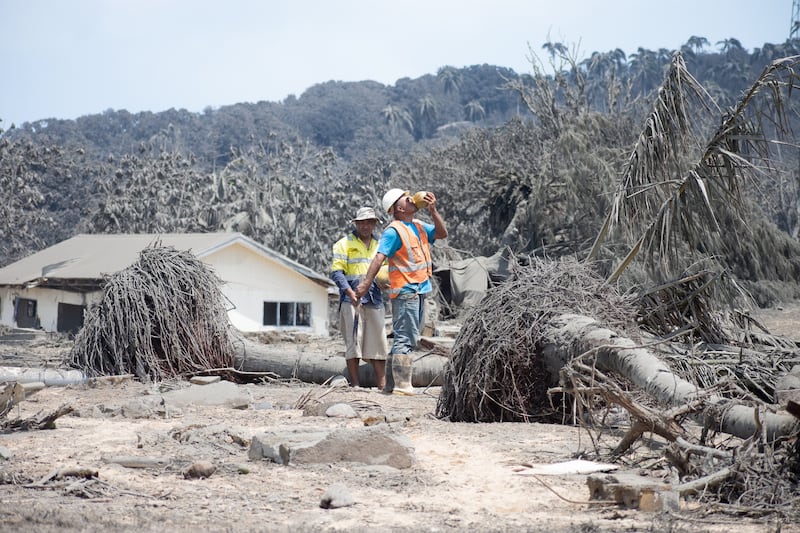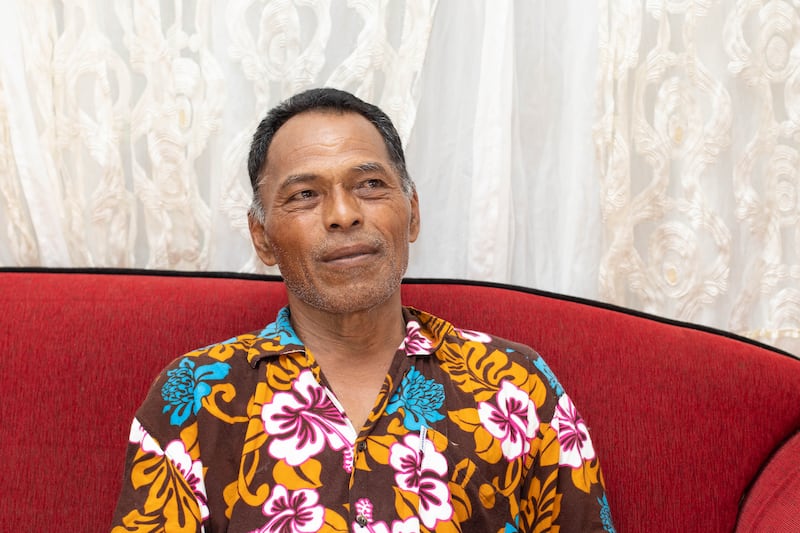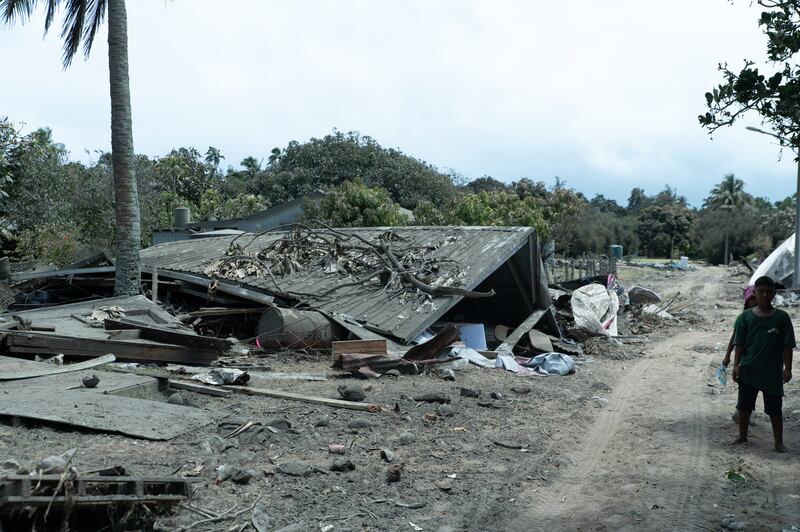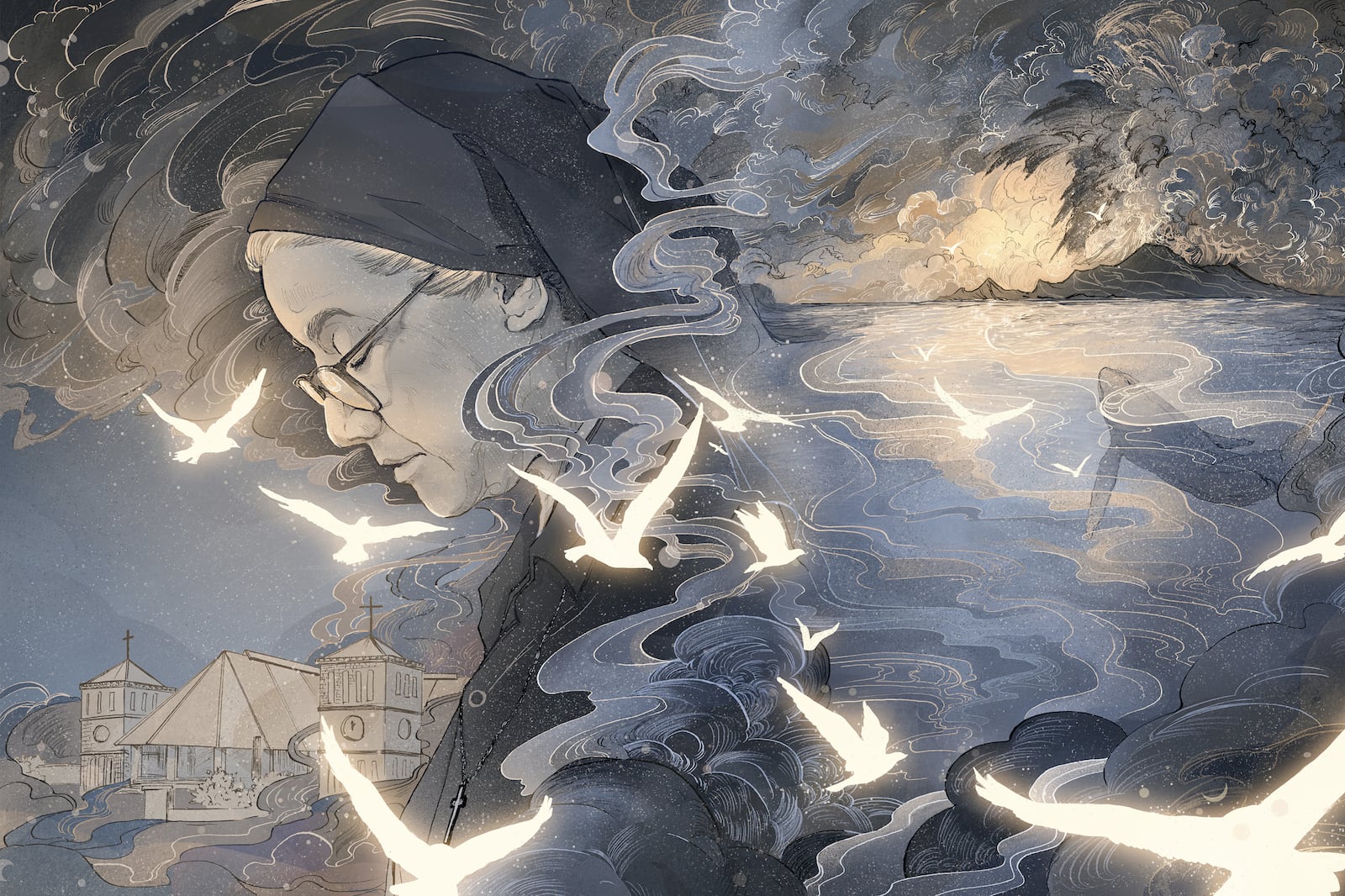Sister Sesilia Alamoti arrived in the Tongan capital of Nuku’alofa on the morning of January 15, 2022. She’d come to prepare for the upcoming diocesan synod — a meeting where she and her fellow Marist Missionary Sisters, together with priests and other interested Catholics, could explore the future of their church. The hopeful gathering took place in an ominous shadow. Three weeks earlier, on December 20, the Hunga Tonga-Hunga Ha’apai volcano had begun belching plumes visible from the shoreline of Nuku’alofa, about 40 miles away. It had been declared dormant by January 11, but on the 14th, it resumed with newfound fury, spewing ash and water vapor 12 miles into the sky and prompting Tongan authorities to declare a tsunami warning.
By early the next day, though, the warning had been lifted, and when the meeting ended around 3:30 p.m., Sister Alamoti and a fellow nun decided to have lunch at a fancy spot along the northern shoreline of Tongatapu, the island home to 70 percent of Tonga’s population. Their food hadn’t yet arrived when a thunderous blast swept through the cafe, like a gust of wind across their feet. A second, larger blast followed, colliding with bodies and bones at a subatomic level and shattering windows across the nation. The volcano had erupted again, triggering, at last, the tsunami. Not that Sister Alamoti knew. Still sipping her beverage, she adjusted her rectangular transition lenses to get a better look. “The sea is strange,” she told her companion. “It seems to be — rising.” Glancing up and down the street, she could make out the faint, undeniable outlines of people running.
Lisala Folau, a fisherman, was among those running. Not on Tongatapu, but about four miles away, on a smaller outpost called Atatā. He’d been headed to the bush to start cooking a Sunday feast when his family informed him of the unusual tides. At 57, with leather-like wrinkles in his knuckles and a pronounced limp from years of manual labor (and soccer), he couldn’t afford to wait and see. His family started moving, migrating from their home on the western side of the island, about a football field away from the shoreline, to higher ground in the east. But the water had already begun to overtake the land, so Folau, his brother and his nephew decided to climb the web-like branches of a tree and take shelter in the viny canopy. When the worst of it seemed to have passed, they climbed back down and plunged into the knee-deep tide. That, it turned out, was the prelude. The big wave was coming.
Neither Folau nor Sister Alamoti knew the extent of what had just been set in motion by a fusion of chilled seawater mixing suddenly with pressurized magma. The resulting eruption was later declared the most powerful in modern history, outmatching the force of the strongest nuclear bomb ever tested. And the tsunami it unleashed licked its way up shorelines across Tonga’s 36 inhabited islands carried away homes and livelihoods in its wake.
Folau and Sister Alamoti, like thousands of Tongans across the archipelago, knew that their faith could sustain them. Faith in God — and faith in each other. Like Lisala Folau’s faith that he’d see his brother again, even as that brother yelled obscenity-laden warnings at him from atop an elevated plastic water tank as the big wave approached. His words were too late. The 20-foot surge swept Folau off his feet and into the mercy of a fast-moving slurry of brown water and debris. He tumbled through the surf, willing himself to the surface for air, bobbing up and down seven times in all. With the sky darkening, rock fragments falling and his family watching, Folau disappeared beneath the waves.
Tonga is one of the most believing nations in the world. It’s also one of the most disaster prone.
On Sundays in Tonga, local radio stations hum Christian hymns, and streets empty of traffic aside from the Tongan faithful, wearing ta’ovalas — traditional, woven skirts — as they shuffle past shuttered restaurants and storefronts en route to their congregations. In some cases, they stand outside and listen to angelic harmonies an hour before services are scheduled to begin. Latter-day Saints are especially prominent; church estimates claim more than 60 percent of Tongans as members — the highest per-capita population of any country in the world by a whopping 20 percentage points. Their presence stretches back to 1891, while Wesleyan Christianity became established following the baptism of King George Tupou I in 1831. Whether Latter-day Saint, Wesleyan, Catholic or members of the Free Church of Tonga — a local Wesleyan offshoot — upwards of 99 percent of Tongans subscribe to some form of Christianity, making Tonga one of the most believing nations in the world.
It’s also one of the most disaster prone. Tonga was rated third-worst in the world, trailing only Vanuatu and the Solomon Islands, in the 2021 World Risk Index. Throughout its history, it has suffered from eruptions (a big one called Kuwae in 1452 supposedly caused “climatic disturbances” worldwide), earthquakes, floods, tsunamis and cyclones. Tongatapu is especially exposed since it’s almost completely flat. Yet in spite of that instability, the Tupou dynasty continues to rule the Kingdom of Tonga, with the original’s 63-year-old great-great grandson, George Tupou VI, sitting atop the throne since March 2012. Perhaps this combination of vulnerability and stability explains why much of the United States paid little attention to the Hunga Tonga-Hunga Ha’apai eruption and its aftermath. The severing of the nation’s undersea fiber-optic cable also didn’t help, forcing Tonga into complete isolation from the outside world.

It’s very rare, explains University of California, Santa Cruz volcanologist Ricky Garza-Giron, for a volcanic eruption to spew its contents more than 12 miles high. The Hunga Tonga-Hunga Ha’apai eruption, however, exceeded 35 miles, reaching the mesosphere and marking “the first time,” Garza-Giron says, “with modern geophysical instrumentation like satellite imagery, that we see a plume like this.” And the shockwaves created by the blast registered not just in the eardrums of Tongans, but on barometers throughout the planet.
The scientific understanding of the eruption provided some clarity to the outside world, but it said nothing about the life-or-death situation on the ground. Shrouded by the eruption’s vale, Folau, for one, figured his eighth gasp for air would be his last.
Somehow, in the adrenaline rush of that moment, he grabbed hold of a small log big enough to keep him afloat. He called out into the darkening sky and heard a lone woman’s voice answer. He located her and saw she’d managed to climb atop a floating board. They tried to keep each other calm, shrieking across the waves: “Are you OK? Are you OK?” During their third exchange, they lost contact. Folau was alone beneath an ashen sky. He knew the tides; he’d spent his career turning to them for sustenance by harvesting fish, octopus, clams — whatever he could either feed to his family or sell at the market. That offered some hope. He was also a man with grated knees, little mobility and no way to call for help, adrift in an angry sea.

Sister Alamoti knows something of divine intervention. Born to a “staunch Catholic” mother in an outlying Tongan island, she moved to the Ma’ufanga neighborhood of Tongatapu at seven years old and attended a school operated by Marist Missionary Sisters. These women came from New Zealand and Australia and America, leaving their families behind in service to a higher power. Sister Alamoti found that inspiring, and her parents bolstered the message at home. Particularly her mother, who carried a tattered rosary in her purse to whip out at a moment’s notice. In Tonga, you never know when you’ll need a prayer.
As she approached her 21st birthday, the only life Sister Alamoti wanted was one of faith and devotion. She entered the convent shortly thereafter, spending a year in Tongatapu before completing training in New Zealand in the early 1980s. Her obedience to her order took her all over the world, starting with Fiji, the Philippines, then back to Tonga. She wanted to go to Madagascar, got assigned to Algeria instead, then couldn’t go there either because of friction between Christian missionaries and the country’s Muslim majority. Instead she was sent to Senegal, then New Zealand, then Vanuatu, and finally Tonga once more in 2014. “Auntie,” her niece often tells her, “where in the world haven’t you been?”
During her travels, she met many people of many creeds — including Catholics with distinct traditions and methods of worship. Tongans are not more faithful than any of them, she believes. But the Tongan faith is strong enough, she also believes, to be its own miracle of sorts. When disaster arrives, as it often does in Tonga, the key to the people’s resilience is as simple as her mother’s rugged rosary: “Their faith,” Sister Alamoti says. “Their trust in God.” It’s a deceptively simple answer. Surviving destruction requires supplies and funds and manpower and popular will. But to Sister Alamoti and many Tongans, it also requires surrender. An acknowledgement of how small we are; a brief, fleeting snapshot of the discrepancy of scale between us and everything beyond us; and a willingness to leap into that abyss anyway.
Folau took that leap when he accepted that, at best, rescuers would find him in the morning. He knew they wouldn’t be out looking for him at night. The risks posed by reefs and debris were too great. So he did the only thing he could think to do. Like Sister Alamoti, he embraced surrender. And when he ran out of prayers to offer, he turned to a Wesleyan hymn: “Jesus, Lover of My Soul.” In the delirium and uncertainty of the black water, still clinging to his log, Folau sang to himself until the words and the waves seemed to blend together.
Lisala Folau and Sister Alamoti, like thousands of Tongans across the archipelago, knew that their faith could sustain them.
When she saw people running, Sister Alamoti herself rushed to her residency beside the Cathedral of St. Mary, an imposing pair of twin gray-stone towers and a cone-shaped green roof. The plume of vapor had turned black. The cathedral’s neighborhood, right along the shoreline, had been deserted. She found a fellow member of her order tending their garden. “Sister, go inside,” Sister Alamoti urged. “There is a tsunami.”
Sister Alamoti sprinted up the stairs to make a better assessment. The water was already swamping the city. Across the street, in an asphalt lot normally home to a secondhand clothing market, imperiled boats took the place of cars, with trash swirling throughout as though atop an airport baggage belt. Sister Alamoti suggested the sisters move farther inland, toward the Basilica of St. Anthony of Padua, where the order maintained a second residence. Her superior wouldn’t allow it. This residence was home to older sisters, one of whom was bedridden while another suffered from dementia. At first Sister Alamoti, as any devout member of a religious order would, accepted her superior’s judgment. But when she returned to the front of their living quarters, she saw the water beginning to cross the road, heading right for their front door.
She and two other sisters decided to head toward the basilica, opting to drive up Queen Salōte — a back road — rather than the usual seafront strip, already submerged. The rockfall began as they reached their destination, prompting a new group to return to the cathedral for the stragglers. The ashfall started during their return, blinding their sedan on a street suddenly emptied — except one vehicle that appeared right in front of them. They used the lights from that vehicle to find their way, prompting the driver to declare a minor miracle upon returning.
As the night unfolded, Sister Alamoti leaned once more on the power of surrender. She would pray the rosary every two hours, she informed the gathering of some 15 people at their basilica-adjacent home. Anyone who wanted to could join. Most eventually fell asleep, but not her. She kept praying until 6 a.m. In between, she didn’t have much to talk about with those who remained awake. Everyone, it seemed, had succumbed to their own version of shock, which took different forms. For her, it meant thanking God for keeping her alive amid whatever was happening outside.
The next morning, the sisters and their guests woke to empty stomachs. “When we realized we were still alive,” Sister Alamoti says, “our hunger came back.” They found some bread around the house, and managed to secure porridge and bottles of water in Sister Alamoti’s hometown of Ma’ufanga. They stayed together, huddled in that house, for five long days. They didn’t want anyone checking on them. “We were much better off than most people,” she says.
Indeed, still adrift, Folau couldn’t even consider food. Shortly after sunrise broke on Sunday, he found himself run aground on Tufaka Island, an uninhabited outpost about a third of the way between Atatā and Tongatapu. It’s rocky, and he couldn’t really go onto the land. He also couldn’t alert a yellow police boat as it sped past toward what had been his home, leaving him bobbing in its wake.

For the next few hours, a different boat — red with twin outboard engines — made five or six trips between Tongatapu and Atatā, again within eyesight and earshot; again too far away and loud to see him. He knew those boats would be carrying his family and the rest of his village to safety, which offered some comfort — and new resolve. Knowing the tides as he did, he recognized low tide was approaching and figured a particular current might be able to carry him to the mainland. His family, meanwhile, badgered officials with questions about his whereabouts. About search parties and rescue missions. By then, his name was all over the radio airwaves — the only communications technology still working. He was presumed dead.
By 6 p.m., Folau had ridden a new flotation device — a torso-sized slab of plywood — to another small island, Polo’a, more than halfway to the shoreline of Tongatapu. He yelled for help, knowing the area was a popular clamming spot. No one answered. But, once more, he felt invigorated by his progress and decided the time was right for a final push, hoping to reach solid land before nightfall.
When he drifted into the rocky beach of the Sopu neighborhood around 9 p.m., he mustered all the strength he had left to say a prayer. Through the ashen fog, he also managed to spot a house in the distance. His legs were in no shape to get him there. He decided to crawl.
On his way, he found a sturdy branch that helped him get back onto his feet. Once more upright, he limped along a battered shoreline road. No one was home at the house, nor at a nearby Ministry of Fisheries office. He spotted a lone car, but it was driving in the wrong direction and couldn’t see him through the still-heavy ashfall; luckily the next car he spotted was headed his way. When Folau told his rescuers his name, they recognized him immediately. “They’re looking for you,” he was told.
They offered him a ride to his sister’s house, less than a mile away. Upon arrival, the driver screamed toward the two-story home: “Hello! We have the missing person.” No one called back. He tried again, still without luck. Finally, he used Folau’s name. The lights flickered on, and eyes poked out from behind the curtains. The front door opened.
In Tongatapu, funerals are very public occasions. Grieving families hang black sheets trimmed with purple outside their homes, alerting the neighborhood to their loss. Sometimes they parade through the streets on foot, the island’s traffic brought to a standstill by their processions. And they bury their loved ones in elaborate, colorful graves nestled right into their neighborhoods, right beside their homes. They’ll often erect a printed billboard to place atop the tombstone, featuring the deceased’s face. Funerals also require, by social obligation, a feast. Cows and pigs are slaughtered, butchered, roasted and served, alongside baked cassava and purple sweet potatoes and, perhaps, a kava bowl. In short, Tongan funerals are labor-intensive community events. They require planning and resources and input.
That process was already underway when Folau walked inside. Not only among members of his family, but members of the Atatā community. They’d all assembled to mourn him, and to decide what to do next. After 30 hours at the mercy of the tides, the man presumed dead had walked into preparations for his own funeral.
The 20-foot surge swept Folau off his feet and into the mercy of a fast-moving slurry of brown water and debris. The eruption was later declared the most powerful in modern history, outmatching the force of the strongest nuclear bomb ever tested.
Before the mass commemorating the one-year anniversary of the eruption begins, a video montage trots along on a projection screen near the altar. Few in the packed Cathedral of St. Mary appear to pay the images of destruction and mayhem much attention, opting instead for either quiet contemplation or Sunday morning chatter as pigeons coo in the rafters and barefoot children dart in and out of the main aisle. Until a few minutes past 10 in the morning, when solemn bells toll and a procession of more than a dozen priests, deacons and altar boys chugs along through the haze of humidity and incense. A choir directed by a sweaty, baton-wielding man in a gold tie belts traditional-sounding hymns backed by brass accompaniment. And at the front of the church, co-celebrants place three wreaths beneath the altar, commemorating the victims lost.
Remarkably, given the gravity of the eruption and tsunami, only four people across Tonga died. But the physical carnage still reveals itself in sheets of scrap metal wrapped around trunks of coconut palms in the western part of Tongatapu, or in the mangled, overgrown automobiles carried into forest clearings by the waves now rusting away in the tropical sun. To eulogize the lives lost and the destruction still clinging to the periphery of everyday existence, the pulpit belongs to Sister Alamoti.

Her speech, largely in Tongan with a few snippets in English, touches first on memorializing. On remembering. “Tonga was thrust into complete darkness,” she says. “Not only was there a physical darkness; power was also cut off, and our underwater communications cable destroyed, isolating Tonga from the rest of the world.”
Speaking beneath the outstretched arms of Christ, who hangs from the far wall on a giant crucifix, the question of why such a thing would happen here hardly needed to be spoken. “A lot of natural disasters are what we make ourselves,” she told me later. “Look at global warming.” And though this particular disaster was not climate change-related, in her eyes, it still fits into a pattern. “A lot of countries in the world — especially first-world countries — seem to be showing off their might, their ammunition,” she tells the crowd in Tongan. She asks the congregation to pray that those countries might spend less on bullets and more on disaster prevention research; on childhood cancer treatments; on using the gifts and talents of the Lord to solve ailments, rather than exacerbate them. And more than anything, she tells the crowd, today is a day to embrace hope. To remember that even in the worst of times, small miracles abound. “We gather here today to offer God our prayers of thanksgiving. We thank him for protecting Tonga,” she concludes in English. “We have realized the immensity of what took place on the fateful day, but God has proven He is more powerful.”
Lisala Folau couldn’t argue. With every church on the island marking the date in their own ways, he spent the anniversary in Atatā Si’i, a new settlement in the western part of Tongatapu, where many of his former neighbors have been relocated into newly constructed homes. A year from his brush with death, he still returns to the sea to provide for his family. He still looks out toward his former home, where the scars of the tsunami remain visible in missing segments of canopy. And he still thinks about those harrowing 30 hours, though never for too long; he, like so many others, has to swallow his feelings whole. With few mental health resources available, the only option is to move on.
He’s started constructing a new home beside his sister’s, using money sent by his son, a migrant fruit picker in Australia. He’d just begun pouring the foundation a few days before the celebration in Atatā’si, which didn’t mention or include him in any special way. That was fine with him. His story has already become a local legend, a sort of modern folklore. A local news segment on Pasifika TV a few nights earlier highlighted a radio program where families from all over the island called in to share their own stories of triumph and heroism. The segment ended with an observation shared by Folau and his family: “Today, after sharing their experiences,” the anchor said, “they can only say, ‘Thank you, Lord, for saving us.’”
This story appears in the April issue of Deseret Magazine. Learn more about how to subscribe.

